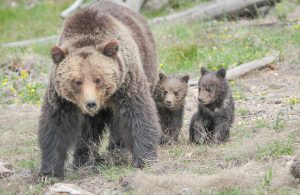The U.S. Fish and Wildlife Service (USFWS) made the right call when they denied a petition by the State of Idaho to remove ALL grizzly bear populations in the lower 48 from the endangered species list. Recovery goals for grizzly bear populations in North and North Central Idaho have not been achieved, and Idaho isn’t prepared to take on the primary role of grizzly bear management within our borders.
On the same day that the USFWS denied Idaho’s petition, the agency found that petitions by the States of Montana and Wyoming to remove the Northern Continental Divide and Yellowstone grizzly bear populations “may be warranted.” The Service’s response to Montana and Wyoming’s petitions is likely different from their response to Idaho because recovery goals for Northern Continental Divide and Yellowstone Ecosystems appear to have been achieved. Whether Montana and Wyoming will responsibly manage those populations if given the authority is another question.
Delisting grizzly populations should only occur after recovery goals have been met. In North and North Central Idaho, more work is needed to recover the Selkirk, Cabinet-Yaak, and Bitterroot grizzly populations.
Idaho’s experience with the delisting of wolves emphasizes the importance of assuring minimum population sizes and clarifying state management approaches after grizzly bears are delisted. One of the ways to provide those assurances is through “Conservation Strategies,” which are formal agreements made between state fish and wildlife management agencies and the USFWS.
A Conservation Strategy for the Yellowstone population was approved in 2016 by the States of Montana, Wyoming, and Idaho and the USFWS. This agreement includes a minimum population range and outlines management obligations of each state. While mostly protective, this plan could be improved by adding more staff and resources to limit the potential for conflicts between humans and grizzlies. The Idaho Department of Fish & Game (IDFG) currently has only one full-time position for grizzly bear management in the Island Park area.

In North Idaho, state and federal wildlife managers recently agreed to begin drafting a similar Conservation Strategy for the Selkirk and Cabinet-Yaak Ecosystems. This is a good step forward, and we hope to see commitments from Idaho to increase staff and resources for grizzly management in the Panhandle. IDFG currently employs one permanent employee and one seasonal employee for grizzly bear work in the north. Given the distinctness of, and distance between the communities of Priest Lake, the east side of Bonner County, and Boundary County, IDFG should deploy one full-time staff person in each of these areas to assist with both proactive and defensive grizzly bear management efforts. This will require funding, and the State and Federal Government must invest in these efforts before delisting occurs.
Finally, any discussion about delisting grizzly bear populations should include Tribes. While state fish and wildlife departments are generally the primary managers of non-listed species, there is increasing recognition that Tribes can and should play a role in the management of fish and wildlife within their traditional territories through co-management and even Tribal-led management arrangements. Tribes with traditional territories in grizzly country likely have something to say about delisting and who should have a hand in managing grizzlies post-delisting. Notwithstanding the need to honor Tribal treaty rights, we owe it to Tribes to consult with them on grizzly bear delisting, and their knowledge and experience will lead to better outcomes for both humans and wildlife.
At the end of the day, we’ll all be served well if we can sit down and discuss these issues, instead of arguing with each other in a courtroom. Right now, Idahoans have an opportunity to help shape the future of grizzly bears in our state. Take action for Idaho’s grizzlies today by contacting Governor Brad Little below, and ask the state to adopt responsibly management plans for grizzlies in Idaho!
To learn more about the issues facing Idaho’s iconic wildlife, sign up for our Wildlife Program updates here.

